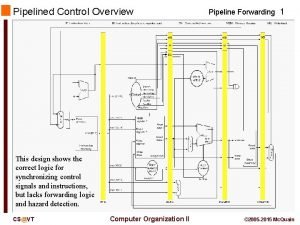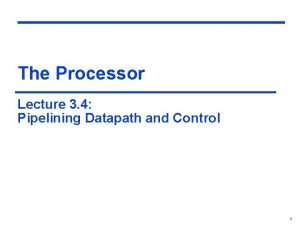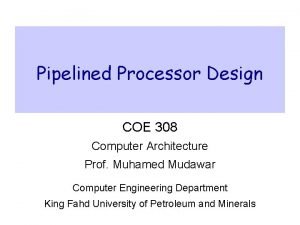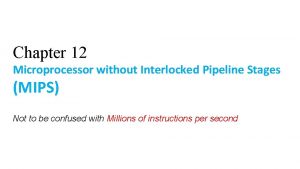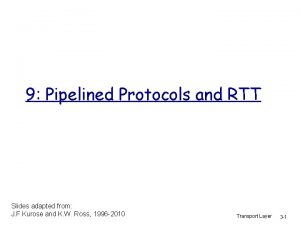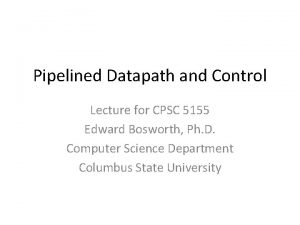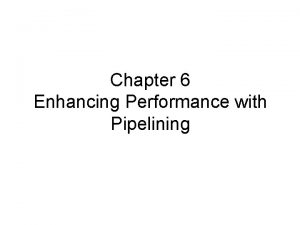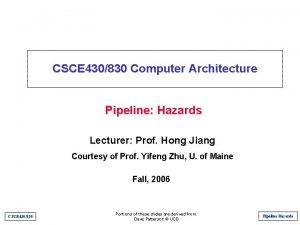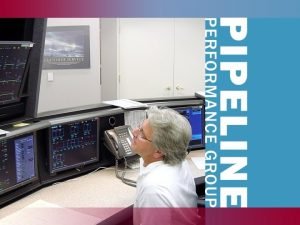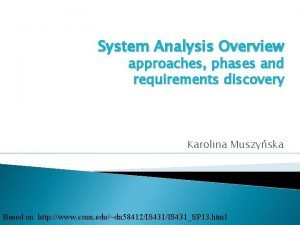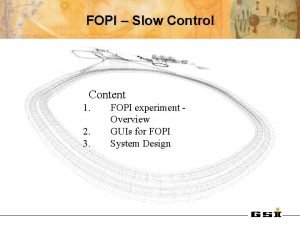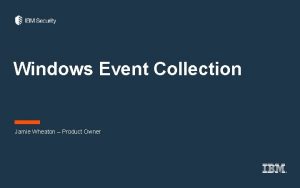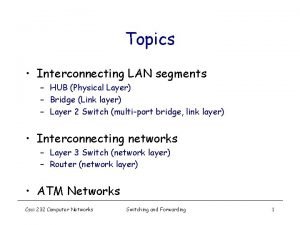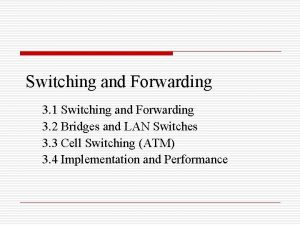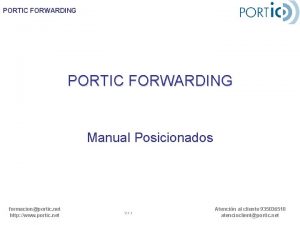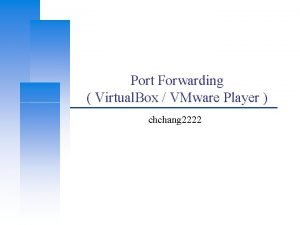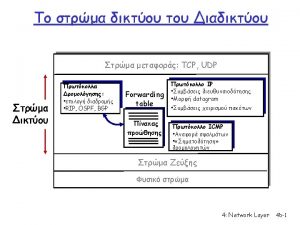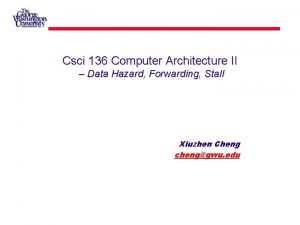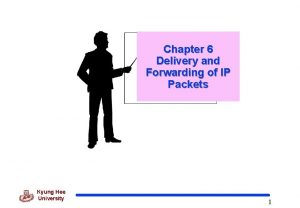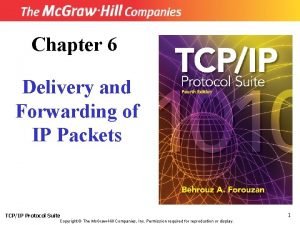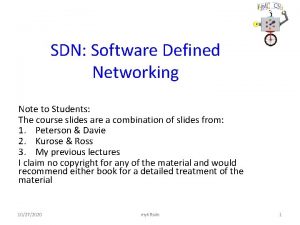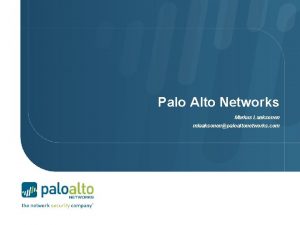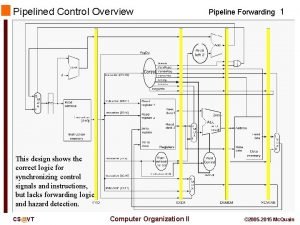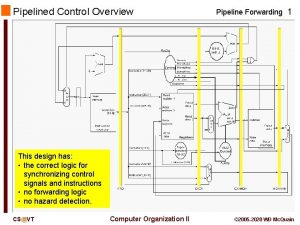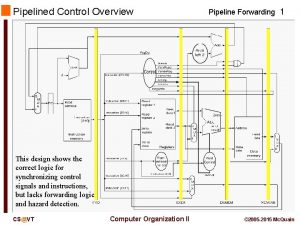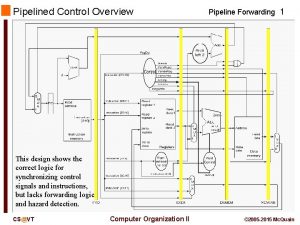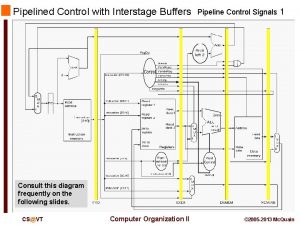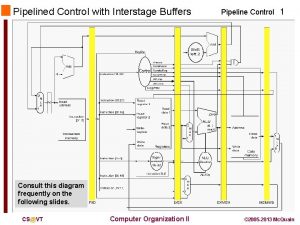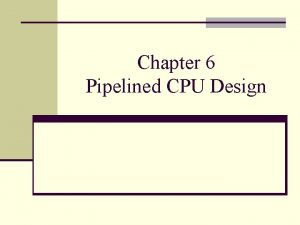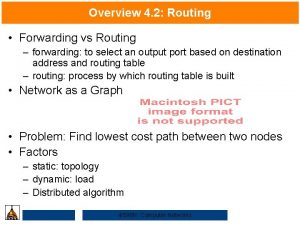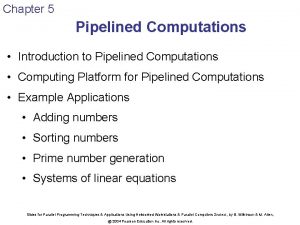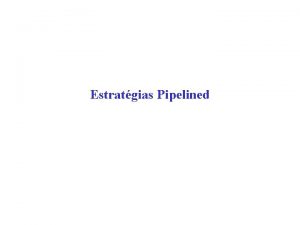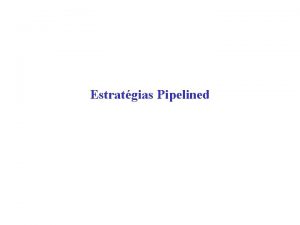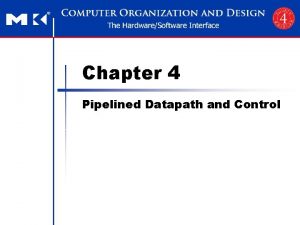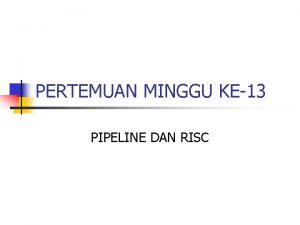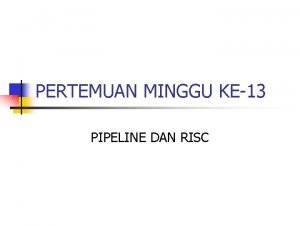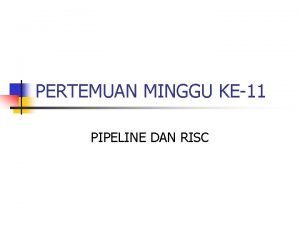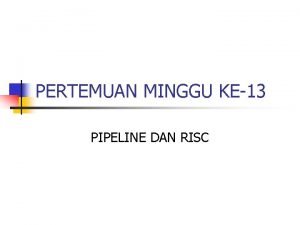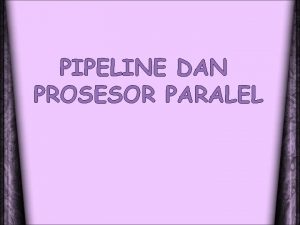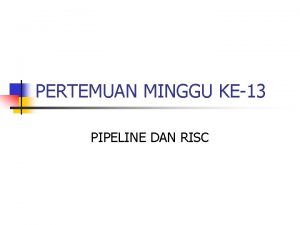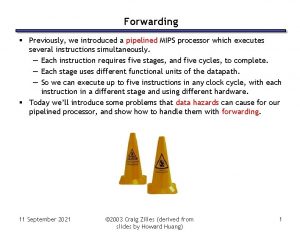Pipelined Control Overview Pipeline Forwarding 1 This design




























- Slides: 28

Pipelined Control Overview Pipeline Forwarding 1 This design shows the correct logic for synchronizing control signals and instructions, but lacks forwarding logic and hazard detection. CS@VT Computer Organization II © 2005 -2013 Mc. Quain

Data Hazards in ALU Instructions Pipeline Forwarding 2 Consider this sequence: sub $2, $1, $3 and $12, $5 Tick 0: Tick 1: Tick 2: Tick 3: sub and # value for $2 known end of EX stage; # stored in $2 in WB stage # # sub and enters ID stage when sub enters EX; and needs $s 2 when enters EX stage; sub is in MEM stage by then; $2 has not been written yet sub and sub Data hazard? CS@VT Computer Organization II © 2005 -2013 Mc. Quain

Data Hazards in ALU Instructions Pipeline Forwarding 3 So this sequence leads to a data hazard involving $2: sub $2, $1, $3 and $12, $5 Can we resolve the hazard simply by forwarding? Tick 0: Tick 1: Tick 2: Tick 3: sub and sub Yes! But we must deliver the computed value at the right time; the next tick. And, that value will be sitting in the EX/MEM interstage buffer. CS@VT Computer Organization II © 2005 -2013 Mc. Quain

Detecting the Hazard Pipeline Forwarding 4 On the one hand, this is obvious. The first instruction writes a value into a register that is subsequently used as input by the second instruction: sub $2, $1, $3 and $12, $5 We must know the register numbers for both instructions in order to detect the hazard. More precisely, we must know rd for the first instruction and both rs and rt for the second instruction. So, we must save those register numbers, via the interstage buffers. Some notation will help us speak precisely about what's going on: B. Register. RX = register number for RX sitting in interstage pipeline buffer B CS@VT Computer Organization II © 2005 -2013 Mc. Quain

A Glance Ahead Pipeline Forwarding 5 Passing the register numbers: rs (left operand) register number rt (right operand) register number CS@VT rd (destination) register number Computer Organization II Logic “box” that manages forwarding of operands © 2005 -2013 Mc. Quain

A Glance Ahead Pipeline Forwarding 6 Passing the register numbers: 2 1 3 1: rd for instruction currently in EX stage 2: rd for instruction currently in MEM stage 3: rd for instruction currently in WB stage They may all be different! CS@VT Computer Organization II © 2005 -2013 Mc. Quain

Detecting the Hazard Pipeline Forwarding 7 Now, for this sequence of instructions: sub $2, $1, $3 and $12, $5 So, we detect the hazard because we see that: EX/MEM. Register. Rd == ID/EX. Register. Rs Hence, we must forward the ALU output value from the EX/MEM interstage buffer to the rs input to the ALU. Apparently, we'll need to: - pass (at least some) register numbers forward via the interstage buffers add a logic unit to compare those register numbers to detect hazards add data connections to support transferring data values being forwarded add some more selection logic (multiplexors) CS@VT Computer Organization II © 2005 -2013 Mc. Quain

Data Hazards in ALU Instructions Pipeline Forwarding 8 Now, consider this sequence: sub $2, $1, $3 and $12, $5 # value for $2 known in EX stage # enters ID stage when sub enters EX or # enters ID stage when sub enters MEM; # $2 has not been written yet Tick 0: Tick 1: Tick 2: Tick 3: Tick 4: $13, $6, $2 sub and or sub and sub Data hazard? CS@VT Computer Organization II © 2005 -2013 Mc. Quain

Data Hazards in ALU Instructions Pipeline Forwarding 9 Again, we have a data hazard: sub $2, $1, $3 and $12, $5 or $13, $6, $2 Tick 0: Tick 1: Tick 2: Tick 3: Tick 4: sub and or # value for $2 known in EX stage # enters ID stage when sub enters EX # enters ID stage when sub enters MEM; sub and or sub and sub Yes! Now, we must deliver the computed value after a delay of one tick, from MEM/WB. CS@VT Computer Organization II © 2005 -2013 Mc. Quain

Detecting the Hazard Pipeline Forwarding 10 Again, we have a data hazard: sub $2, $1, $3 and $12, $5 or $13, $6, $2 So, we detect the hazard because we see that: MEM/WB. Register. Rd == ID/EX. Register. Rt Hence, we must forward the ALU output value from the MEM/WB interstage buffer to the rt* input to the ALU. So… detecting data hazards is a multi-stage affair. * QTP: why does this one go to the rt input? CS@VT Computer Organization II © 2005 -2013 Mc. Quain

Data Hazards in ALU Instructions Pipeline Forwarding 11 Now, consider this sequence: sub $2, $1, $3 and $12, $5 or $13, $6, $2 # value for $2 known in EX stage; # enters ID stage when sub enters EX; # enters ID stage when sub enters MEM; add $14, $2 # enters ID stage when sub enters WB; # $2 has not been written yet, but. . . Tick 0: Tick 1: Tick 2: Tick 3: Tick 4: sub and or add sub and or sub and sub Data hazard? CS@VT Computer Organization II © 2005 -2013 Mc. Quain

Data Hazards in ALU Instructions Pipeline Forwarding 12 Now, there's almost a hazard… but not quite… sub $2, $1, $3 and $12, $5 or $13, $6, $2 add $14, $2 Tick 0: Tick 1: Tick 2: Tick 3: Tick 4: Tick 5: CS@VT sub and or add # # value for enters ID sub and or add $2 known in EX stage when sub and or stage; enters EX; enters MEM; enters WB; sub and sub Now, we deliver the computed value to the register file in the first half of tick 4, and it's not read until the second half of that tick! Computer Organization II © 2005 -2013 Mc. Quain

Data Hazards in ALU Instructions Pipeline Forwarding 13 Now, consider this sequence: sub $2, $1, $3 and $12, $5 or $13, $6, $2 add $14, $2 # # sw # enters ID stage after sub is done Tick 0: Tick 1: Tick 2: Tick 3: Tick 4: Tick 5: $15, 100($2) sub and or add sw value for enters ID sub and or add $2 known in EX stage when sub and or stage; enters EX; enters MEM; enters WB sub and Data hazard? CS@VT Computer Organization II © 2005 -2013 Mc. Quain

Detecting the Need to Forward Pipeline Forwarding 14 Here's what we (seem to) know so far: ALU-related data hazards occur when EX/MEM. Register. Rd = ID/EX. Register. Rs EX/MEM. Register. Rd = ID/EX. Register. Rt Fwd from EX/MEM pipeline reg MEM/WB. Register. Rd = ID/EX. Register. Rs MEM/WB. Register. Rd = ID/EX. Register. Rt Fwd from MEM/WB pipeline reg However, we have overlooked (at least) one thing… CS@VT Computer Organization II © 2005 -2013 Mc. Quain

Detecting the Need to Forward Pipeline Forwarding 15 We don't need to forward unless the forwarding (earlier) instruction does actually write a value to a register: EX/MEM. Reg. Write == 1 MEM/WB. Reg. Write == 1 And we only forward if Rd for that instruction is not $zero: EX/MEM. Register. Rd != 0 MEM/WB. Register. Rd != 0 CS@VT Computer Organization II © 2005 -2013 Mc. Quain

Datapath Change: ALU Operand Selection Pipeline Forwarding 16 Value from register fetch in ID stage Value from WB stage Value from ALU execution Forwarding unit selects among three candidates for the register operands. CS@VT Computer Organization II © 2005 -2013 Mc. Quain

Datapath Change: ALU Operand Selection CS@VT Computer Organization II Pipeline Forwarding 17 © 2005 -2013 Mc. Quain

Forwarding Paths Pipeline Forwarding 18 Select source for left operand rs Select source for right operand rt Possible rd numbers rs and rt for the instruction in the EX stage, ID/EX. Register. Rs ID/EX. Register. Rt Select correct rd number rd # from WB stage, rd # from MEM stage, MEM/WB. Register. Rd EX/MEM. Register. Rd CS@VT Computer Organization II © 2005 -2013 Mc. Quain

Conditions for EX Hazard Pipeline Forwarding 19 If ( EX/MEM. Reg. Write and EX/MEM. Register. Rd != 0 and EX/MEM. Register. Rd == ID/EX. Register. Rs ) then Forward. A = 10 If ( EX/MEM. Reg. Write and EX/MEM. Register. Rd != 0 and EX/MEM. Register. Rd == ID/EX. Register. Rt ) then Forward. B = 10 QTP: could BOTH occur with respect to the same instruction? CS@VT Computer Organization II © 2005 -2013 Mc. Quain

Conditions for MEM Hazard Pipeline Forwarding 20 If ( MEM/WB. Reg. Write and MEM/WB. Register. Rd != 0 and MEM/WB. Register. Rd == ID/EX. Register. Rs ) then Forward. A = 01 If ( MEM/WB. Reg. Write and MEM/WB. Register. Rd != 0 and MEM/WB. Register. Rd == ID/EX. Register. Rt ) then Forward. B = 01 QTP: could BOTH an EX hazard and a MEM hazard occur with respect to the same instruction? CS@VT Computer Organization II © 2005 -2013 Mc. Quain

Double Data Hazard Pipeline Forwarding 21 Consider the sequence: add $1, $2 sub $1, $3 or Tick 2: Tick 3: CS@VT Both hazards occur… which value do we want to forward? $1, $4 or. . . sub or add sub Computer Organization II add © 2005 -2013 Mc. Quain

Double Data Hazard Pipeline Forwarding 22 Consider the sequence: add $1, $2 add $1, $3 add $1, $4 Revise MEM hazard condition: – Only forward if EX hazard condition is not true CS@VT Computer Organization II © 2005 -2013 Mc. Quain

Revised Conditions for MEM Hazard Pipeline Forwarding 23 If ( MEM/WB. Reg. Write and MEM/WB. Register. Rd != 0 and not ( EX/MEM. Reg. Write and EX/MEM. Register. Rd != 0 and EX/MEM. Register. Rd == ID/EX. Register. Rs ) and MEM/WB. Register. Rd == ID/EX. Register. Rs ) then Forward. A = 01 If ( MEM/WB. Reg. Write and MEM/WB. Register. Rd != 0 and not ( EX/MEM. Reg. Write and EX/MEM. Register. Rd != 0 and EX/MEM. Register. Rd == ID/EX. Register. Rt ) and MEM/WB. Register. Rd == ID/EX. Register. Rt ) then Forward. B = 01 CS@VT Computer Organization II © 2005 -2013 Mc. Quain

MEM Hazard Breakdown If ( ( MEM/WB. Reg. Write and MEM/WB. Register. Rd != 0 ) Pipeline Forwarding 24 Instruction leaving MEM stage DOES write a value and not ( EX/MEM. Reg. Write and EX/MEM. Register. Rd != 0 and EX/MEM. Register. Rd == ID/EX. Register. Rs ) and MEM/WB. Register. Rd == ID/EX. Register. Rs ) then Forward. A = 01 CS@VT Computer Organization II Instruction leaving EX stage DOES NOT write a value OR it doesn’t write to Rs register of instruction leaving ID stage Instruction leaving MEM stage DOES write a value to the Rs register of instruction leaving ID stage © 2005 -2013 Mc. Quain

Simplified Datapath with Forwarding CS@VT Computer Organization II Pipeline Forwarding 25 © 2005 -2013 Mc. Quain

Unsimplified Datapath with Forwarding Pipeline Forwarding 26 Yes: add sub and or slt sw No: lw beq j This design shows the correct logic for synchronizing control signals and instructions, and forwarding logic, but lacks hazard detection. CS@VT Computer Organization II © 2005 -2013 Mc. Quain

A Question to Ponder Pipeline Forwarding 27 Consider the following scenario: add lw $t 1, $t 2, $t 3 $t 1, ($t 2) rs rt The Forwarding unit design sees $t 1 as an input register for the second lw. . . So it would forward. . . needlessly. Is that a problem? How could we fix this? CS@VT Computer Organization II © 2005 -2013 Mc. Quain

A Question to Ponder Pipeline Forwarding 28 Consider the following scenario: add lw $t 1, $t 2, $t 3 $t 1, ($t 2) rs rt The Forwarding unit design sees $t 1 as an input register for the second lw. . . So it would forward. . . needlessly. Is that a problem? How could we fix this? CS@VT Computer Organization II © 2005 -2013 Mc. Quain
 Double data hazard
Double data hazard Pipelined datapath
Pipelined datapath Pipelined processor design
Pipelined processor design Difference between linear and nonlinear pipeline
Difference between linear and nonlinear pipeline Scalar pipeline vs vector pipeline
Scalar pipeline vs vector pipeline Interlocked pipeline
Interlocked pipeline Pipelined protocols
Pipelined protocols Pipelined datapath
Pipelined datapath Pipelined datapath
Pipelined datapath Pipeline control hazard
Pipeline control hazard Pipeline control room management
Pipeline control room management System analysis
System analysis System design overview
System design overview Split range
Split range Owner
Owner Forwarding table example
Forwarding table example Forwarding table example
Forwarding table example Rcn call manager
Rcn call manager Portic forwarding
Portic forwarding Vmware player port forwarding
Vmware player port forwarding Mpls control plane and data plane
Mpls control plane and data plane Interplay between routing and forwarding
Interplay between routing and forwarding Aam adobe
Aam adobe Forwarding data hazard
Forwarding data hazard Delivery and routing of ip packets
Delivery and routing of ip packets Delivery and forwarding of ip packets
Delivery and forwarding of ip packets Examples of sdn
Examples of sdn Palo alto policy based forwarding
Palo alto policy based forwarding Datagram forwarding table
Datagram forwarding table
